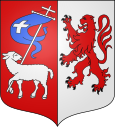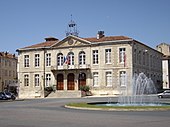Also
| Also | ||
|---|---|---|

|
|
|
| region | Occitania | |
| Department | Gers | |
| Arrondissement | Also | |
| Canton |
Auch-1 (main town) Auch-2 (main town) Auch-3 (main town) |
|
| Community association | Grand Auch Cœur de Gascogne | |
| Coordinates | 43 ° 39 ′ N , 0 ° 35 ′ E | |
| height | 115-281 m | |
| surface | 72.48 km 2 | |
| Residents | 21,935 (January 1, 2017) | |
| Population density | 303 inhabitants / km 2 | |
| Post Code | 32000 | |
| INSEE code | 32013 | |
| Website | Also | |
 Also - Cathedral and Tour d'Armagnac |
||
Also [ oʃ ] is a town and a French commune with 21,935 inhabitants (as of January 1, 2017) in the Gers department (32) in the Occitania region . The city lies on the Way of St. James ( Via Tolosana ) and is the seat of an archbishopric .
Location and climate
Also located on a hill by the river Gers at an altitude of approx. 145 m. The city of Toulouse is approx. 80 km (driving distance) to the east. The climate is temperate; Rain (approx. 755 mm / year) falls over the year.
Population development
| year | 1800 | 1851 | 1901 | 1954 | 1999 | 2017 |
| Residents | 7,696 | 12,141 | 13,939 | 16,382 | 21,838 | 21,935 |
The urban population grew significantly in the 20th century, mainly due to the immigration of families from the rural areas in the area ( rural exodus ).
economy
For centuries, many townspeople of earlier centuries lived largely on the yields of their fields and their home gardens which were close to the village; however, there were also street vendors selling milk, cheese, vegetables and spices. Small traders, craftsmen and service providers of all kinds were almost exclusively dependent on them and the food processing industries such as millers, bakers, butchers, etc. In the 19th century, the construction of a gas works and a railway station favored the development of the districts of the lower town. Since the 1960s, several industrial areas (zones industrielles) have emerged in front of the city .
history
The name can also be traced back to the Aquitanian tribe of the Auscer who lived this area at the time of the Roman conquest of Gaul by Julius Caesar , around 50 BC. BC, inhabited. Roman sources mention the city, which was the main town of the Auscer, as Eliumberrum , which is considered to be the Romanization of a Basque name meaning "New Town" (from the word stems iri and berri ). In the middle Roman Empire , the city was then called Augusta Auscorum and was located on the road from Burdigala (now Bordeaux ) to Tolosa (now Toulouse ); according to the ancient geographer Pomponius Mela ( De chorographia 3, 20) it was very important.
The Christianity held in the area of Auch around the end of the 3rd century collection, and the city was probably in the 4th century seat of a bishop. From the beginning of the 5th century it belonged to the Visigoth Empire for about a century and after the Battle of Vouillé (507) it came to the Empire of the Franks . It was on the right bank of the Gers until 732; But when it was devastated by the Saracens that year , the refugees rebuilt the place on a hill on the left bank of the river. In 843 Auch was devastated again, this time by the Normans . After the destruction of Eauze by the Normans around the middle of the 9th century, its ecclesiastical administrative district was united with the diocese of Auch. The latter was raised to an archbishopric in 879 during the tenure of Bishop Ayrard ; the archbishops of Auch held the title of Primate of Aquitaine until the outbreak of the French Revolution (1789) .
In the 10th century, Count Bernard I of Armagnac founded the Benedictine Abbey of Saint Orens in Auch , whose monks shared jurisdiction over the city with the local archbishops until 1308, which led to constant conflicts. In 1068 the cardinal and papal legate Hugo le Blanc held a church assembly here, at which it was determined, among other things, that almost all churches in Gascony should pay the fourth part of their tithes to the cathedral of Auch. In one of the clashes between the archbishops and the monks of Saint Orens, the latter marched armed towards the cathedral on April 28, 1119, wounded the archbishop who was just celebrating mass, killed many believers and set fire to the cathedral.
From 1140 the Counts of Armagnac , who succeeded those of Fézensac , resided in the castle of Auch. Since 1160, Bernard IV of Armagnac shared control of the urban area of Auch with the local archbishop, who hoped for the support of the count in return through this agreement. Synods , mostly related to ecclesiastical discipline , presided over by local archbishops, took place in Auch in the years 1279, 1300, 1308, 1324 and 1330.
When the French King Philip IV conquered Guyenne in 1295 , Auch, which like all of Armagnac had come under English rule, became French again. At that time, royal agents negotiated with the prior of Saint Orens and the archbishop of Auch in order to give the king supremacy over the city. In 1308, the prior of Saint Orens ceded all rights to the city to Philip IV. From 1330 onwards, King Philip VI divided. and the archbishop the rights of jurisdiction - a regulation that was repealed as early as December 1339 on the ideas of the Count of Armagnac.
In the Hundred Years War (1337-1453) fell to England through the Treaty of Brétigny (1360), but came back to France in 1371. During the last revolt of Count Jean V of Armagnac in 1473, the troops of King Louis XI conquered . after the sack of Lectoure Also for the French crown domain. As a result, the city became the seat of a royal court. To underline the importance of Auch as a religious center, the archbishops had the imposing Sainte-Marie cathedral built on the ruins of the burned-down old Romanesque cathedral from 1489 onwards, which still dominates the cityscape today .
The Protestant Reformation found numerous followers in Auch since 1556/57. The intervention of the later Marshal Monluc , who was summoned in 1561, was intended to counteract this development; but since the prior and the monks of Saint Orens converted to the Protestant faith in the following year, this new denomination remained in rudimentary form. During the subsequent Huguenot Wars , the city was always in the possession of the Catholics, apart from their occupation by Huguenots under Count Gabriel of Montgomery in 1569 , which they soon gave up.
After France was subdivided into generals, Auch first belonged to that of Montauban . In 1716, however, the "Generality Auch and Pau" was created from parts of the areas of this generalship and that of Bordeaux . The first directors resided more often in Pau than in Auch. During the reign of King Louis XV. was Antoine d'Mégret Étigny , who worked here from 1751 to 1767 as director, much to uplift the city and its trade and its economy in - he left many important buildings like the town hall building. After his death in 1767, the Pau generals were separated from those of Auch, but were reunited with them four years later. In the 18th century, Gascony was also the capital . Since the beginning of the French Revolution (1789/90) it has been the administrative seat of the Gers department.
Attractions
- Sainte-Marie is also known for its late Gothic cathedral from the 15th to 17th centuries and its magnificent choir stalls (stalles) . Since 1998 it has been part of the UNESCO World Heritage " Paths of the Pilgrims of St. James in France ".
- Also worth mentioning is “La Tour d'Armagnac”, a prison tower from the 14th century, at the top of the monumental staircase built in the middle of the 19th century that leads up from the Gers to the cathedral. The lower end of this staircase is guarded by the statue of the Musketeer d'Artagnan , a character in a novel by Alexandre Dumas based on the real life of Charles de Batz, Comte d'Artagnan. He spent his childhood and youth here.
- The Maison Fédel is an elaborately designed half-timbered house with several cross- frame windows from the 15th century over a stone ground floor, which has probably always housed business premises.
- Today's town hall (Hôtel de Ville) is located in the former Palais des Intendanten Étigny. It was built in the years 1760–1778.
- The former archbishop's palace from the years 1750-1770 now serves as the seat of the prefecture of the Gers department.
- From the former Franciscan convent (Couvent de Cordeliers) only a part of the late Gothic cloister (cloître) and the chapter house (salle capitulaire) are preserved.
- Also of the former priory of Saint-Orens on the banks of the Gers, only a cubic tower from the 14th century is preserved.
- The Collège Salinis was founded around the middle of the 16th century; today's buildings date mainly from the 18th century.
- The Musée des Jacobins shows exhibits from the city's history, but also from Central America.
- outside
- The Château de Marin and the Château de Saint-Cricq are each about 5 km southeast of Auch.
Town twinning
Personalities
Sons and daughters
- Dominic Serres (1719–1793), painter
- Louis Thomas Villaret de Joyeuse (1747-1812), Admiral
- Jean Joseph Paul Dessolles (1767–1828), marquis and French general
- Jean Laborde (1805–1878 in Madagascar), adventurer and entrepreneur
- Arnaud Denjoy (1884–1974 in Paris), mathematician
- Nicolas Portal (1979–2020), racing cyclist
Associated with also
- Orientius von Auch († around 439), poet, bishop and saint
- Aspasius von Auch († 560), abbot and saint
see also: List of Archbishops of Auch
Web links
- Also, tourism site - photos + information (French)
- Also - cathedral (French)



